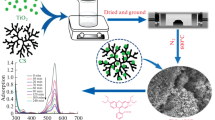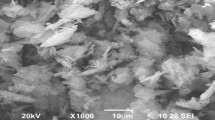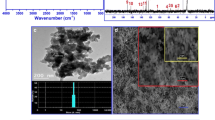Abstract
The present research combines biosorption and photocatalysis in a functional TiO2-immobilized chitosan adsorbent (CTA). CTA can degrade organic pollutants and adsorb metal ions simultaneously. Target pollutants were dyes of cationic (rhodamine B, Rh.B) and anionic (methyl orange, MO) nature, with Ni2+ and Cu2+ selected as heavy metals. The presence of Ni2+ or Cu2+ improved the degradation ability of CTA for MO, but inhibited the degradation of Rh.B, with Cu2+ exhibiting stronger effects than Ni2+. There was no significant difference in CTA activity when the metal ions were pre-adsorbed or when they coexisted in the solution with the organic dyes. Protons in the reaction system affected the degradation performance in a similar way for Ni2+ and Cu2+ leading to a different effect on the degradation for MO and Rh.B. An X-ray photoelectron spectroscopy analysis of the binding energies of the metal ions on the surface in the presence of the cationic or anionic dyes explained the different behaviors. Since anionic and cationic dyes possess chromogenic groups of different charges, they adversely affect the production of OH• radicals when coexisting with Cu2+ or Ni2+.











Similar content being viewed by others
References
Gupta, V. K., Carrott, P. J. M., Ribeiro Carrott, M. M. L., & Suhas (2009). Low cost adsorbents: growing approach to wastewater treatment—a review. Critical Reviews in Environmental Science and Technology, 39, 783–842.
Van Gauwbergen, D., & Baeyens, J. (2002). Modeling and scale-up of reverse osmosis separation. Environmental Engineering Science, 19, 37–45.
Baeyens, J., Mochtar, I. Y., Liers, S., & Dewit, H. (1995). Plugflow dissolved air flotation. Water Environment Research, 67, 1027–1035.
Dewil, R., Appels, L., Baeyens, J., Buczynska, A., & Van Vaeck, L. (2007). The analysis of volatile siloxanes in waste activated sludge. Talanta, 74, 14–19.
Hall, S., Tang, R., Baeyens, J., & Dewil, R. (2009). Removing polycyclic hydrocarbons from water by adsorption of silica gel. Polycyclic Aromatic Compounds, 29, 160–183.
Neyens, E., Baeyens, J., Weemaes, M., & De Heyder, B. (2002). Advanced biosolids treatment using H2O2-oxidation. Environmental Engineering Science, 19, 27–35.
Neyens, E., & Baeyens, J. (2003). A review of classic Fenton’s peroxidation as an advanced oxidation technique. Journal of Hazardous Materials, 97, 295–314.
Bailey, S. E., Plin, T. J., Bricka, R. M., & Adrain, D. D. (1999). A review of potentially low cost sorbents for heavy metals. Water Research, 33, 2469–2479.
Ali, I., & Gupta, V. K. (2006). Advances in water treatment by adsorption technology. Nature Protocols, 1, 2661–2667.
Gupta, V. K., Mittal, A., Malviya, A., & Mittal, J. (2009). Adsorption of carmoisine A from wastewater using waste materials—bottom ash and deoiled soya. Journal of Colloid and Interface Science, 335, 24–33.
Gupta, V. K., Mittal, A., Gajbe, V., & Mittal, J. (2008). Adsorption of basic fuchsin using waste materials—bottom ash and deoiled soya as adsorbents. Journal of Colloid and Interface Science, 319, 30–39.
Gupta, V. K., Mittal, A., Jain, R., Mathur, M., & Sikarwar, S. (2006). Adsorption of Safranin-T from wastewater using waste materials-activated carbon and activated rice husks. Journal of Colloid and Interface Science, 303, 80–86.
Gupta, V. K., Ali, I., & Saini, V. K. (2007). Adsorption studies on the removal of Vertigo Blue49 and Orange DNA13 from aqueous solutions using carbon slurry developed from a waste material. Journal of Colloid and Interface Science, 315, 87–93.
Gupta, V. K., Suhas, Ali, I., & Saini, V. K. (2004). Removal of rhodamine B, fast green and methylene blue from wastewater using red mud—an aluminum industry waste. Industrial and Engineering Chemistry Research, 43, 1740–1747.
Gupta, V. K., Mittal, A., Kurup, L., & Mittal, J. (2006). Adsorption of a hazardous dye, erythrosine, over hen feathers. Journal of Colloid and Interface Science, 304, 52–57.
Gupta, V. K., Ali, I., Saini, V. K., Gerven, T. V., Bruggen, B. V., & Vandecasteele, C. (2005). Removal of dyes from waste water using bottom ash. Ind. Engg. Chem. Res., 44, 3655–3664.
Gupta, V. K., Gupta, B., Rastogi, A., Agarwal, S., & Nayak, A. (2011). A comparative investigation on adsorption performances of mesoporous activated carbon prepared from waste rubber tire and activated carbon for a hazardous azo dye-acid blue 113. J. Hazardous Mat., 186, 891–901.
Gupta, V. K., & Ali, I. (2008). Removal of endosulfan and methoxychlor from water on carbon slurry. Environmental Science and Technology, 42, 766–770.
Jain, R., Mathur, M., Sikarwar, S., & Mittal, A. (2007). Removal of the hazardous dye rhodamine B through photocatalytic and adsorption treatments. Journal of Environmental Management, 85, 956–964.
Yu, J. C., Yu, J. G., & Zhao, J. C. (2002). Enhanced photo-catalytic activity of mesoporous and ordinary TiO2 thin films by sulfuric acid treatment. Applied Catalysis B: Environmental, 36, 31–43.
Li, J. Y., Chen, C. C., Zhao, J. C., Zhu, H. Y., & Orthman, J. (2002). Photodegradation of dye pollutants on TiO2 nanoparticles dispersed in silicate under UV–VIS irradiation. Applied Catalysis B: Environmental, 37, 331–338.
Zertal, A., Molnár-Gábor, D., Malouki, M. A., Sehili, T., & Boule, P. (2004). Photocatalytic transformation of 4-chloro-2-methylphenoxyacetic acid (MCPA) on several kinds of TiO2. Applied Catalysis B: Environmental, 49, 83–89.
Han, W. Y., Zhu, W. P., Zhang, P. Y., Zhang, Y., & Li, L. S. (2004). Photocatalytic degradation of phenols in aqueous solution under irradiation of 254 and 185 nm UV light. Catalysis Today, 90, 319–324.
Wu, C. H., Chang-Chien, G. P., & Lee, W. S. (2004). Photodegradation of polychlorinated dibenzo-p-dioxins: comparison of photocatalysts. Journal of Hazardous materials B, 114, 191–197.
Jain, R., & Shrivastava, M. (2008). Photocatalytic removal of hazardous dye cyanosine from industrial waste using titanium dioxide. Journal of Hazardous Materials, 152, 216–220.
Gupta, V. K., Jain, R., Mittal, A., Mathur, M., & Sikarwar, S. (2007). Photochemical degradation of the hazardous dye Safranin-T using TiO2 catalyst. Journal of Colloid and Interface Science, 309, 464–469.
Parra, S., Sarria, V., Malato, S., Peringer, P., & Pulgarin, C. (2000). Photochemical versus coupled photochemical–biological flow system for the treatment of two biorecalcitrant herbicides: metobromuron and isoproturon. Applied Catalysis B: Environmental, 27, 153–168.
Macak, J. M., Zlamal, M., Krysa, J., & Schmuki, P. (2007). Self-organized TiO2 nanotube layers as highly efficient photocatalysts. Small, 3, 300–304.
Paulose, M., Shankar, K., Varghese, O. K., Mor, G. K., Hardin, B., & Grimes, C. A. (2006). Backside illuminated dye-sensitized solar cells based on titania nanotube array electrodes. Nanotechnology, 17, 1446–1448.
Tennakone, K., & Wijayantha, K. G. U. (2005). Photocatalysis of CFC degradation by titanium dioxide. Applied Catalysis B: Environmental, 57, 9–12.
Mozia, S., Tomaszewska, M., & Morawski, A. W. (2005). A new photocatalytic membrane reactor (PMR) for removal of azo-dye Acid Red 18 from water. Applied Catalysis B: Environmental, 59, 131–137.
Bowering, N., Walker, G. S., & Harrison, P. G. (2006). Photocatalytic decomposition and reduction reactions of nitric oxide over Degussa P25. Applied Catalysis B: Environmental, 62, 208–216.
Cheung, W. H., Ng, J. C. Y., & McKay, G. (2003). Kinetic analysis of the sorption of copper(II) ions on chitosan. Journal of Chemical Technology and Biotechnology, 78, 562–571.
Chu, K. H. (2002). Removal of copper from aqueous solution by chitosan in prawn shell: adsorption equilibrium and kinetics. Journal of Hazardous Materials, 90, 77–95.
Juang, R. S., & Shao, H. J. (2002). A simplified equilibrium model for sorption of heavy metal ions from aqueous solutions on chitosan. Water Research, 36, 2999–3008.
Chen, S. M., Yen, M. S., & Shen, Y. H. (2010). Effect of chitosan biopolymer and UV/TiO2 method for the de-coloration of acid blue 40 simulated textile wastewater. African Journal of Biotechnology, 34, 5575–5580.
Su, H. J., Wang, Z. X., & Tan, T. W. (2005). Preparation of a surface molecular-imprinted adsorbent for Ni2+ based on Penicillium chrysogenum. Journal of Chemical Technology and Biotechnology, 80, 439–444.
Zhao, X. L., Li, Q., Zhang, X., Su, H. J., Lan, K., & Chen, A. Z. (2011). Simultaneous removal of metal ions and methyl orange by combined selective adsorption and photocatalysis. Environmental Progress & Sustainable Energy. doi:10.1002/ep.10507.
Murakami, N., Chiyoya, T., Tsubota, T., & Ohno, T. (2008). Switching redox site of photocatalytic reaction on titanium(IV) oxide particles modified with transition-metal ion controlled by irradiation wavelength. Applied Catalysis A: General, 348, 148–152.
Teh, C. M., & Mohamed, A. R. (2010). Roles of titanium dioxide and ion-doped titanium dioxide on photocatalytic degradation of organic pollutants (phenolic compounds and dyes) in aqueous solutions: a review. Journal of Alloys and Compounds, 12, 117–130.
Aarthi, T., & Madras, G. (2008). Photocatalytic reduction of metals in presence of combustion synthesized nano-TiO2. Catalysis Communications, 9, 630–634.
Gözmen, B., Turabik, M., & Hesenov, A. (2009). Photocatalytic degradation of Basic Red 46 and Basic Yellow 28 in single and binary mixture by UV/TiO2/periodate system. Journal of Hazardous Materials, 164, 1487–1495.
Devi, L. G., Murthy, B. N., & Kumar, S. G. (2010). Photocatalytic activity of TiO2 doped with Zn2+ and V5+ transition metal ions: influence of crystallite size and dopant electronic configuration on photocatalytic activity. Materials Science and Engineering B, 166, 1–6.
Huo, H. Y., Su, H. J., Jiang, W., & Tan, T. W. (2009). Effect of trace Ag+ adsorption on degradation of organic dye wastes. Biochemical Engineering Journal, 43, 2–7.
Fu, G. H., Cai, W. P., Gan, Y. J., & Jia, J. H. (2004). Ambience-induced optical absorption peak for Au/SiO2 mesoporous assembly. Chemical Physics Letters, 385, 15–19.
Ni, M., Leung, K. H., Leung, Y. C., & Sumathy, K. (2007). A review and recent developments in photocatalytic water-splitting using TiO2 for hydrogen production. Renewable and Sustainable Energy Reviews, 11, 401–425.
Abe, R., Sayama, K., & Arakawa, H. (2002). Efficient hydrogen evolution from aqueous mixture of I− and acetonitrile using a merocyanine dye-sensitized Pt = TiO2 photocatalyst under visible light irradiation. Chemical Physics Letters, 362, 441–444.
Nie, Y. L., Hu, C., Qu, J. H., & Zhao, X. (2009). Photoassisted degradation of endocrine disruptors over CuOx–FeOOH with H2O2 at neutral pH. Applied Catalysis B: Environmental, 87, 30–36.
Foster, N. S., Noble, R. D., & Koval, C. A. (1993). Reversible photoreductive deposition and oxidative dissolution of copper ions in titanium dioxide aqueous suspensions. Environmental Science and Technology, 27, 350–356.
Ward, M. D., & Bard, A. J. (1982). Photocurrent enhancement via trapping of photogenerated electrons of titanium dioxide particles. Journal of Physical Chemistry, 86, 3599–3605.
Kiwi, J., Pulgarin, C., Peringer, P., & Gratzel, M. (1993). Beneficial effects of homogeneous photo-Fenton pretreatment upon the biodegradation of anthraquinone sulfonate in waste water treatment. Applied Catalysis B: Environmental, 3, 85–99.
Okamoto, K. I., Yamamoto, Y., Tanaka, H., Tanaka, M., & Itaya, A. (1985). Heterogeneous photocatalytic decomposition of phenol over TiO2 powder. Bulletin of the Chemical Society of Japan, 58, 2015–2022.
Okamoto, K. I., Yamamoto, Y., Tanaka, H., & Itaya, A. (1985). Kinetics of heterogeneous photocatalytic decomposition of phenol over anatase TiO2 powder. Bulletin of the Chemical Society of Japan, 58, 2023–2028.
Sykora, J. (1997). Photochemistry of copper complexes and their environmental aspects. Coordination Chemistry Reviews, 159, 95–108.
Butler, E. C., & Davis, A. P. (1993). Photocatalytic oxidation in aqueous titanium dioxide suspensions: the influence of dissolved transition metals. Journal of Photochemistry and Photobiology A: Chemistry, 70, 273–283.
Acknowledgments
The authors want to express their thanks for the support from the Natural Science Foundation of China (20876008, 21076009), the National Basic Research Program (973 Program) of China (2007CB714305), the (863) High Technology Project (2008AA062401), the Chinese Universities Scientific Fund (ZZ1024), and the Program for New Century Excellent Talents in University (NCET-100212).
Author information
Authors and Affiliations
Corresponding author
Rights and permissions
About this article
Cite this article
Zhao, X., Xiao, G., Zhang, X. et al. The Effect of Ni2+ and Cu2+ on the Photocatalytic Degradation of Dyes by the Chitosan–TiO2 Complex. Appl Biochem Biotechnol 168, 183–197 (2012). https://doi.org/10.1007/s12010-011-9407-8
Received:
Accepted:
Published:
Issue Date:
DOI: https://doi.org/10.1007/s12010-011-9407-8




